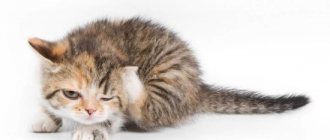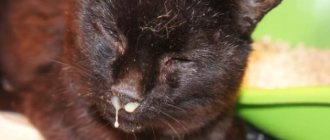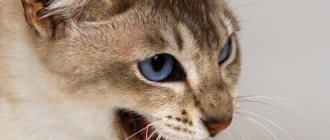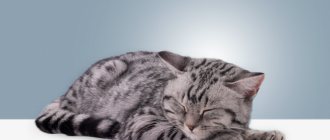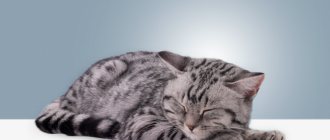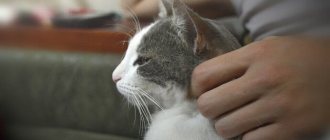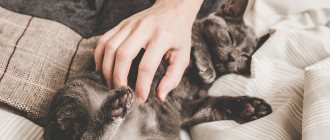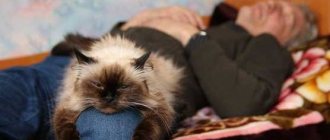Representatives of the feline species spend most of their lives sleeping. These animals love to settle down in a cozy, safe place and choose the most comfortable position. Sometimes a cat twitches in its sleep. A person, seeing such movements, often begins to worry and wonders whether such a phenomenon is normal. What happens to an animal during sleep? What kind of movements during rest can be evidence of the development of pathologies? The answers to such questions are most interesting and important for animal owners.
When cats can shake
Cats can tremble not only in their sleep, but also while awake. The main problem for the owner is determining the cause of the trembling and whether any disease is present.
Read also: Why do shoes squeak when walking?
If this phenomenon occurs quite often, it is necessary to determine the room temperature. If the room temperature is not comfortable for the pet, measures should be taken to provide warmth to the pet. The measure consists of raising the room temperature or providing the animal with warm bedding and eliminating drafts.
It is necessary to provide cats with warm bedding.
Sign that the cat is freezing
A sign that your pet is freezing can be the “curl” position adopted during sleep and a deeply hidden nose.
What causes seizures?
A cat twitches convulsively in its sleep due to the presence of an internal disease or a pathological process caused by parasites. The most common causes of seizures are:
- tumors;
- lymph inflammation;
- brain diseases;
- mental pathologies;
- deficiency of calcium or other substances;
- disturbances in the functions of the peripheral nervous system;
- infection by parasites and others.
When figuring out why cats twitch in their sleep, doctors identify specific diseases, including:
Sleep epilepsy or sleep disorder
How to distinguish between nocturnal seizures, are seizures a manifestation of epilepsy during sleep or is it a sleep disorder?
Differential diagnosis of paroxysmal events during sleep
To clarify the nature of nocturnal attacks, an objective research method is video EEG polysomnography. An option for diagnosing epilepsy in sleep is video EEG monitoring; studies are more informative after sleep deprivation.
Read also: Why do dogs bite cats?
If during a paroxysm epiactivity is simultaneously recorded on the EEG of sleep, then these paroxysms are of epileptic origin, that is, they are epileptic seizures in sleep.
Night attacks can be short and not accompanied by epileptiform EEG discharges; then these disorders of non-epileptic origin are more often classified as parasomnias.
Sleep disorders are often associated with certain stages of sleep and have a characteristic clinical picture.
At an appointment with an epileptologist, there are also options when the patient has nocturnal seizures and epilepsy, but this is not epilepsy.
Let us give a clinical example of seizures during sleep, accompanied by epileptiform activity on the EEG, but not related to epilepsy.
A 3-year-old boy came to see him with nocturnal paroxysms in the form of sleepwalking and sleep-talking. According to my mother: “2 hours after falling asleep, he gets out of bed, says, and walks around the apartment. It's like he's looking for something. More often than not, something is unclear. Some of the words can be understood; they are associated with sleep, with the events of the day. Sometimes the son laughs, cries, moans, is afraid, and is in a hurry. The eyes are open, but the gaze is unconscious or “wild”. After about 10 minutes I manage to calm him down and put him to bed. He falls asleep calmly. After treatment with sedatives, there was a break in his sleepwalking for 4 months, and then gradually became more frequent up to 2-4 times a month.” On the EEG, the patient has epiactivity of the type of benign epileptiform discharges of childhood in a small amount in the background and during sleep. When conducting an EEG with sleep deprivation: during sleep recording, neurophysiologists described a paroxysm (sat down on the bed, did not react, said a few words), but at this moment no epiactivity was noted in the EEG. A diagnosis was made: Parasomnias (sleeping, sleeping). Concomitant diagnosis: Benign epileptiform disorders of childhood. There are currently no data for active epilepsy. Antiepileptic drugs were never prescribed to this patient. Emphasis was placed on the need to maintain a rational daily routine. In therapy, he received sedatives or nootropics in age-related doses in the form of monotherapy (pantothenic acid, adaptol, atarax, phenibut, decoction of sedative herbs, novopassit) in courses of 1-2 months, 1-3 courses per year. The response to such therapy is always good: the parasomnias described above completely stopped for 4-8 months or decreased significantly; could be of an erased nature (sits on the bed in a dream, sits for 3-5 seconds, lies down and sleeps further; no more than 1-2 times a month). The child has been observed by an epileptologist for several years. Over time, complaints about sleep disturbances gradually become less and less. According to the EEG, epiactivity of the DERD type persists: in different recordings it may be in a small index or absent.
The first signs of ischemic stroke
An attack can develop over several hours, and sometimes symptoms increase over the course of a day.
| If assistance for a stroke is provided within the first 3-6 hours - the golden therapeutic window - then severe brain damage can be avoided. |
- A person often has a headache. The localization of pain is difficult to determine. The pain is usually difficult to relieve with medications.
- Muscle weakness occurs, any movement is difficult.
- The person becomes unusually apathetic. Household chores cause him difficulties, and he loses his ability to work.
- Dizziness occurs. They appear even at rest, and intensify when moving.
- Blood pressure “jumps”, which was not the case before.
- Noisy in the ears. Sometimes this feeling can be permanent.
- Memory impairment occurs. It may be difficult for a person to remember recent information.
- Hands and feet, face go numb.
- Sleep disturbances occur. A person sleeps poorly at night and is drowsy during the day. Even after a long rest, you do not feel invigorated.
- Stereoscopic (three-dimensional) vision appears.
- Coordination of movements is impaired.
These signs can appear, disappear, and then return with renewed vigor. If these symptoms appear, it is necessary to begin treatment without delay.
Motor activity during sleep of an adult cat
It is normal for a cat to twitch slightly during sleep once it has passed adolescence. Adaptation of an animal in the outside world and among “its own kind”, strengthening its nervous system, completing the construction of “owner-pet” relationships contributes to its psychological stability. The cat does not experience significant stress and therefore sleeps more peacefully.
In an adult, REM sleep is accompanied by:
- infrequent and not pronounced movements of the paws;
- twitching of the lip, mustache, ears;
- motor activity of the tail;
- rare screams, meows, growls.
If a cat older than two years old experiences emotions characteristic of a kitten in a dream, it is highly likely that it may be diagnosed with behavioral changes - increased nervousness, aggressiveness. It is difficult for such animals to adapt close to humans, and sometimes living together becomes impossible.
Characteristic symptoms
Seizures in cats have specific symptoms. Any attack, no matter what its causes, is accompanied by the following manifestations:
- Severe tension in the affected muscle group (extended limbs, freezing in an unnatural position).
- Characteristic signs of fear (dilated, motionless pupils, flattened ears, rapid breathing).
- The cat may remain motionless for a long time, fearing increased pain.
- At the height of the attack, foam may be released from the mouth or spontaneous urination may occur.
After the attack ends, the cat may appear stunned. For some time she does not recognize her home or the people around her.
Why does a person twitch in his sleep?
Experts have identified several types of night twitches, each of which has its own cause and a specific way of manifesting itself.
A fairly common syndrome that causes short-term spasm of a certain muscle group. This occurs due to uncoordinated muscle tone and a state of complete relaxation. When a person falls asleep, the brain perceives this as a possible state of death. Therefore, the body begins to receive impulses so that the brain makes sure that the person is alive.
If the nerve impulse fails to touch the muscles of the body, the brain sends the signal again, only with more powerful force. Having reached its goal, the impulse disrupts the calm and state of relaxation, thereby provoking involuntary twitching.
Sleep paralysis
Becomes active during the transition from the waking state to the stage of falling asleep. Hallucinations, panic, a feeling of fear, and rapid breathing may occur. Particularly susceptible people imagine otherworldly forces or the presence of intruders in the house.
Common causes of paralysis are disturbances in the day and night routine, severe shocks, stress and a sedentary lifestyle.
An equally common cause of nighttime tremors is “Ekbom's restless legs syndrome.” It is characterized by burning and severe pain in the foot and lower leg when falling asleep or during sleep. The result is an involuntary shaking of one or both legs, causing a sudden awakening.
Treatment of trigeminal neuralgia
Treatment is aimed at:
Read also: What are hazardous working conditions?
- to eliminate the cause of damage;
- to alleviate the patient's condition;
- to stimulate the restoration of nerve structures;
- to reduce the excitability of trigger zones.
Properly selected treatment can reduce the frequency, intensity and duration of pain waves, and ideally achieve stable remission.
Drug treatment
Trigeminal neuralgia requires complex treatment using drugs from several groups:
- anticonvulsants (carbamazepine and analogues): reduce the excitability of nerve fibers;
- muscle relaxants (baclofen, mydocalm): reduce muscle spasms, improve blood circulation, reduce pain;
- B vitamins (neuromultivit, milgamma): stimulate the restoration of nerve fibers, have an antidepressant effect;
- antihistamines (diphenhydramine): enhance the effect of anticonvulsants;
- sedatives and antidepressants (glycine, aminazine): stabilize the patient’s emotional state.
For severe pain, narcotic analgesics may be prescribed. Previously, drug blockades (injecting the problem area with anesthetics) were actively used, but today this method of treatment is almost never used. It contributes to additional damage to nerve fibers.
Physiological causes of trembling
Sometimes a cat trembles due to external factors such as a sudden change or decrease in the temperature of the surrounding area. Physiological factors of tremor also include stress, sexual arousal, deep sleep or some reflex processes in the animal’s body.
Cold
You will often notice that your cat will shiver after swimming or spending a long time outside on a cold day. This tremor is a mechanism of thermoregulation and does not allow the animal to freeze for a long period of time.
Pampered domestic cats get chills even with a slight drop in ambient temperature, while a pet hardened by frequent walks can stay outside for a long time, even in severe frosts. Owners should take into account such individual characteristics of their cats’ bodies to determine the duration of the walk, since hypothermia easily leads to the development of colds and inflammatory pathologies.
Important! Even if the room is warm, the animal's fur must be thoroughly dried after bathing. It is also important to ensure there are no drafts and not to allow the cat to lie on a cold surface.
Emotional excitement
The cat may tremble as if it were cold when there is strong emotional arousal, positive or negative. Both during fear and during times of great joy, a large amount of certain hormones enter the animal’s bloodstream, which provoke muscle tremors.
By this sign you can determine the mood of your pet. For example, when nervous, a cat shakes as if frozen, arches its back, hisses or meows loudly. Sometimes the readiness to attack is expressed only in the shaking of the tail raised up. At the same time, sitting on the lap of its beloved owner, the animal may tremble slightly and purr with pleasure.
Sexual arousal
During the period of sexual heat, all the senses of male cats become more acute. In the absence of a sexual partner, animals are constantly nervous, strive to get out of the house, and may show aggression or excessive intrusiveness. The cat is shaking from the powerful release of sex hormones into the blood. This condition leads not only to mental disorders of the animal, but also provokes the development of malignant tumors of the reproductive organs and mammary glands. Therefore, the most humane way to get rid of the suffering of cats and female cats that do not take part in breeding is castration.
Other reasons
Some cats may experience tremors as a reflex after eating food. It is especially common to notice how a well-fed kitten trembles in its sleep and does not show signs of anxiety.
Sometimes owners have a question about why the cat trembles when he sleeps. Experts even have a special term “sleepy tremor,” which indicates maximum relaxation of all muscles.
A cat may also shiver in its sleep when sleeping indoors with low air temperatures. This is indicated by the animal’s posture - the cat curls up into a tight ball, “burying” its nose as deeply as possible into the fur or under the paw.
Important! If the cat is shaking in its sleep, trying in vain to warm its frozen limbs, but at the same time the room is quite comfortable and warm, then you should measure the pet’s temperature. Her sharp decline indicates a very serious pathology that is life-threatening.
Poor and restless sleep, which is accompanied by periodic twitching of the limbs and tremors in the body, may be a consequence of stress or prolonged physical exertion. Most often, owners observe this condition in their pet after he “defended his rights” to a female during the period of sexual heat.
“Senile tremor” can also be considered normal. Poor circulation and innervation is the reason why an elderly cat shakes when lying or sitting in a relaxed state.
They're too cold
While cats are good at regulating their body temperature , they may still feel cold. Being too cold is a possible reason why your cat twitches when they sleep. Cats have a higher body temperature than humans, around 39°C/102°F. On particularly cold days or winter nights, cats often feel the cold in their small bodies.
In such cases, the cat may even look for you to sleep next to you. By sleeping next to you, they can share your body heat and feel warmer. Some cats may be more prone to cold, especially hairless cats.
How to treat fever in a child who has previously had febrile seizures?
If the child does not have an increase in temperature during illness or after vaccination, it is not recommended to give antipyretic drugs! This does not reduce the risk of an attack.
If the temperature has risen, medications to reduce it make you feel better overall, but do not help with attacks.
The harm from anticonvulsants for the prevention of febrile seizures outweighs the benefits; they are almost never prescribed.
If a child’s febrile convulsions are prolonged, at the beginning of the attack it is recommended to administer a drug from the benzodiazepine group in the form of an enema, a spray in the nose or a gel on the cheek. Unfortunately, none of these forms are registered in Russia. Therefore, if an attack lasts longer than 5 minutes, an emergency doctor may give an injection of such a medicine.
For antipyretic drugs, children can be given ibuprofen at a dose of 10 mg/kg every 8 hours or paracetamol at a dose of 15 mg/kg every 6 hours. Don't give children aspirin!
What to do?
If your sleeping cat twitches regularly, the first thing to do is contact your veterinarians.
The immediate actions of a person during twitching determine the intensity of the manifestations and their characteristic features. If the cat continues to sleep, there is no need to wake it. In the same situations, when the animal’s muscles are cramped by a strong cramp, the pet needs to be helped - wrapped in a blanket or blanket, carried in your arms, and calmed down. In addition, you need to massage the cramped muscle. When massaging, it is important to calculate the force of your own impact so as not to hurt the animal. Often, tickling the heels with a feather or piece of paper helps with paw cramps.
An epileptic seizure deserves special attention. This condition in a cat is not always accompanied by profuse salivation, as in humans; sometimes there is no saliva. The owner’s actions in this situation should be completely similar to how they behave around people during an epileptic attack. If the animal's jaws are tightly closed, there is no need to unclench them - this can cause a fracture. The cat needs to be placed on its side and held in place, since the pounding body moves, that is, the pet can seriously hurt itself against a wall, furniture or something else. At the end of the attack, the cat should be calmed down and consult a doctor without delay.
Factors
- Another possible factor for tremors in a cat may be uncomfortable posture . Cat muscles and joints are capable of reacting this way to being in an uncomfortable position for a long time.
- An equally significant fact can be stress or previously experienced fear . A possible reason is the animal’s excessive activity during hunting and games. As well as the presence of injury or bruise.
The fact that a cat is trembling may be due to stress.
Examining the cat and diagnosing the problem
You can find out why your cat often shakes its head and ears after visiting a veterinary clinic. To make a diagnosis you will need:
take urine and blood tests to determine deviations in basic indicators;
undergo a bacteriological examination (bacterial culture), identifying the pathogen and its sensitivity to antibiotics;
do ultrasound and x-rays necessary to detect internal pathologies, root causes and tumors.
The list of studies is individual and agreed upon locally. In addition to the above, the doctor can perform a biopsy, take a scraping or smear from the damaged area.
Emotional excitement
What to do if your cat is shaking? First you need to find out the reason, and only then take some action. For example, periodic trembling in an animal may appear due to certain emotional states. For example, the cat experienced severe fear, discomfort from the appearance of strangers in the apartment, and aggression arose.
Note that not only negative emotions can cause such conditions in a pet. For example, a cat that is experiencing bliss may also tremble periodically. Some owners notice that when they return after work and the cat is bored, rubs, purrs, and literally shakes with joy. This is the normal state of the animal. Therefore, you should not leave your pet for a long time if it is so hard for you to be separated from you.
The importance of REM sleep in kittens
Kittens are able to dream while still inside the mother cat. Moreover, REM sleep provides neural stimulation, which contributes to the normal development of the brain and the entire nervous system of the embryo. The REM phase is extremely important for newborns and growing animals. Young animals experience dreams especially vividly. Kitty:
- can move its paws;
- beat the tail on the floor;
- roll over from side to side;
- move your ears and cheek muscles;
- breathe rapidly and meow.
Especially often, such violent reactions appear after outdoor games, stress or hunting experience. Running and tired, the baby may fall asleep in an unnatural position with his eyes half-open, which also should not cause concern. Firstly, kittens are like human babies and relax in their sleep without feeling discomfort, and secondly, the presence of a third eyelid in the corner of the eye helps protect the eyeball from drying out.
Features of the nervous system in kittens. The nervous system is formed simultaneously with the growth of the body, so unusual motor activity in kittens in the REM phase is completely normal.
If in adult animals the duration of REM sleep is 15-20 minutes, followed by a longer phase of slow-wave sleep, then in kittens up to six months the REM phase takes up 80% of the total rest time.
If the owner noted that the growing furry pet began to sleep more calmly and practically does not flinch in its sleep, then we can talk about the animal growing up and strengthening the nervous system. The period of stabilization of nervous functions is very individual and is determined by many factors, such as:
- Breed affiliation . In outbred cats, which generally mature faster, psychological maturation begins by 12 months, and representatives of large breeds, growing up to 2-2.5 years, demonstrate elements of childish behavior for quite a long time.
- Character . Temperamental and easily excitable animals require more time for the development of nervous processes than balanced and calm phlegmatic animals.
- Personal negative experiences and traumas . Stress can cause serious damage to the psyche. It has been proven that animals that have experienced fear and pain can return to this episode in their sleep, experiencing real nightmares.
Also watch the video why a cat twitches in its sleep:
Pathologies
It is necessary to diagnose the pathology in time.
Tremor can accompany the development of pathologies, so owners should closely monitor their pet and seek advice from a specialist.
Possible pathologies:
- cat flu;
- panleukopenia;
- rhinotracheitis;
- calicivirus;
- central nervous system disorder;
- kidney damage.
It is necessary to diagnose a possible pathology in time and take all measures to eliminate it.
Prevention
Prevention of trigeminal neuralgia is a set of simple measures that significantly reduce the risk of developing pathology. Doctors recommend:
- undergo regular preventive examinations;
- at the first signs of the disease, seek help (the sooner treatment is started, the greater its effect will be);
- eat right, get the required amount of vitamins, minerals, unsaturated fatty acids;
- regularly engage in light sports and gymnastics;
- get enough sleep and rest;
- minimize stress and physical overload;
- avoid hypothermia and harden yourself;
- to refuse from bad habits.
Veterinarian-guided therapy
The final therapy depends on the diagnosis and general condition of the animal. In especially severe cases, surgical intervention is resorted to. Surgery is necessary if necrosis, abscess, advanced hematoma, narrowing of the ear canal, or deep-lying foreign object is detected. In all other cases, they are limited to taking medications:
antibiotics – for infections;
antihistamines – for allergies and allergic dermatitis;
antiparasitic – for tick and flea infestations;
anti-inflammatory, painkillers and immunomodulators - to relieve associated symptoms and boost immunity.
Regardless of the affected area, the prescribed medications are dripped into both ears. For better divergence of droplets, a light massage of the auricle is recommended. The resulting crusts are soaked and removed, treating the damaged skin with disinfectant solutions.
Hematomas are eliminated with absorbable ointments and cold compresses, as well as UHF therapy. In severe forms, the accumulated fluid is pumped out with a syringe.
Neurological diseases are the most difficult to combat. Treatment of the resulting disorders is individual, and the prognosis directly depends on the degree of damage to the meninges.
